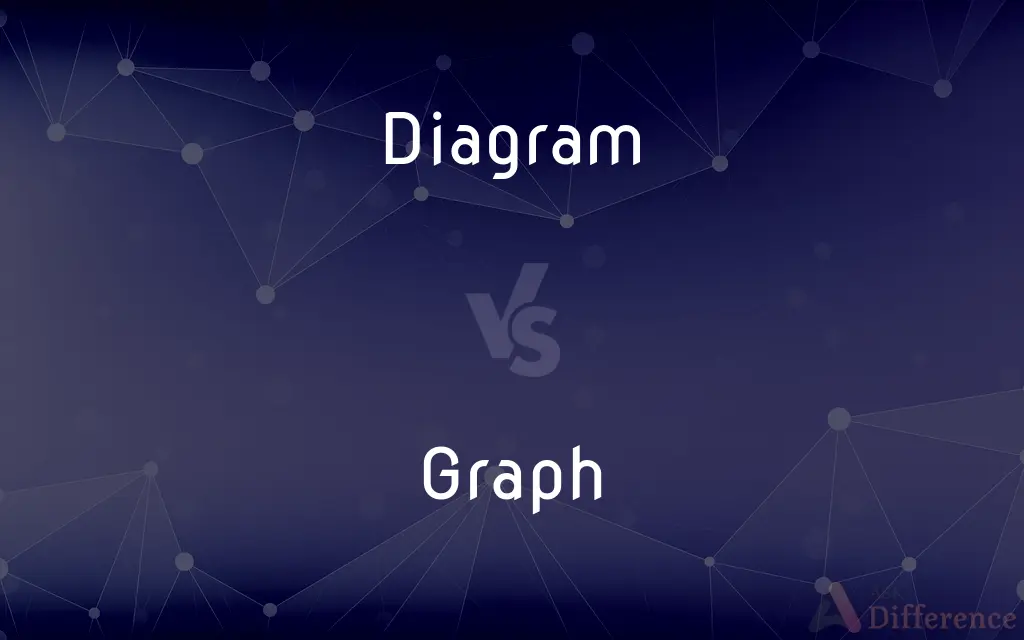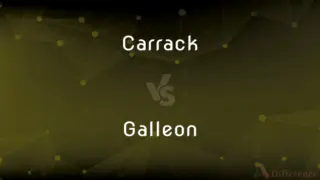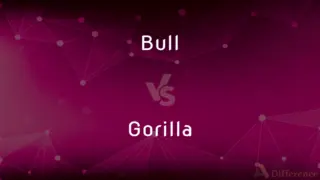Diagram vs. Graph — What's the Difference?
Edited by Tayyaba Rehman — By Maham Liaqat — Updated on March 31, 2024
A diagram is a visual representation designed to explain or show the structure of something, while a graph displays data points and their relationships through coordinates on an axis system.

Difference Between Diagram and Graph
Table of Contents
ADVERTISEMENT
Key Differences
Diagrams are used to illustrate concepts, processes, or layouts in a simplified manner, helping to clarify complex ideas or systems. They can include flowcharts, schematics, and blueprints. Graphs, on the other hand, are focused on quantitatively representing data, such as trends, patterns, or statistical relationships, through plots on axes.
Diagrams often employ symbols, lines, and texts to represent different components or steps in a process, making it easier to understand how parts of a system interact. Graphs use data points, lines, bars, or other markers to visually display numerical information, making trends and patterns easier to identify and analyze.
The purpose of a diagram is mainly explanatory, aiming to provide a clear understanding of how something works or is structured. Graphs aim to present data in a way that allows for analysis and interpretation, often used in scientific research, market analysis, and financial forecasting.
Creating a diagram involves selecting symbols and arranging them to best represent the system or process. The creation of a graph involves plotting data points on a predetermined scale and possibly fitting a line or curve to depict a trend.
Diagrams can be more flexible in their design and composition, not requiring a strict adherence to scale or proportion as long as they convey the intended message. Graphs, however, must be accurately scaled and proportioned to correctly represent the data they are based on.
ADVERTISEMENT
Comparison Chart
Purpose
To explain or show the structure of something.
To display data points and relationships quantitatively.
Representation
Uses symbols, lines, and text.
Uses data points, lines, bars, or curves on axes.
Focus
Conceptual understanding and process flow.
Trends, patterns, and statistical relationships in data.
Creation
Involves selecting and arranging symbols.
Involves plotting data points on a scale.
Design Flexibility
More flexible in design, not bound by scale.
Must be accurately scaled and proportioned.
Compare with Definitions
Diagram
A symbolic representation of information using visual techniques.
The user manual included a wiring diagram for easy setup.
Graph
A tool for analyzing scientific data, often used in experiments.
The students used a graph to present their findings from the chemistry experiment.
Diagram
A chart or plan that outlines the sequence of operations in a process or system.
The project manager created a flow diagram to outline the development process.
Graph
A diagram representing the variation of a variable in comparison with one or more other variables.
The researcher presented a graph showing temperature changes over the year.
Diagram
A simplified drawing showing the appearance, structure, or workings of something.
The architecture student drew a diagram of the building’s layout.
Graph
A mathematical representation of data on a coordinate plane.
We plotted the company's quarterly profits on a graph for the past five years.
Diagram
A graphic designed to explain complex data simply.
The textbook featured diagrams to explain cellular respiration.
Graph
A chart used in presentations to convey information effectively.
The sales team used graphs to display their monthly sales achievements.
Diagram
A visual representation used in teaching to illustrate a point or a concept.
The teacher drew a diagram of the water cycle on the board.
Graph
A visual representation of statistical data to identify trends.
The graph in the report illustrated the rise in market demand.
Diagram
A diagram is a symbolic representation of information using visualization techniques. Diagrams have been used since ancient times on walls of caves, but became more prevalent during the Enlightenment.
Graph
A diagram that exhibits a relationship, often functional, between two sets of numbers as a set of points having coordinates determined by the relationship. Also called plot.
Diagram
A simplified drawing showing the appearance, structure, or workings of something; a schematic representation
A diagram of the living room
Graph
A pictorial device, such as a pie chart or bar graph, used to illustrate quantitative relationships. Also called chart.
Diagram
Represent (something) in graphic form
The experiment is diagrammed on page fourteen
Graph
The spelling of a word.
Diagram
A plan, sketch, drawing, or outline designed to demonstrate or explain how something works or to clarify the relationship between the parts of a whole.
Graph
Any of the possible forms of a grapheme.
Diagram
(Mathematics) A graphic representation of an algebraic or geometric relationship.
Graph
A written character that represents a vowel, consonant, syllable, word, or other expression and that cannot be further analyzed.
Diagram
A chart or graph.
Graph
To represent by a graph.
Diagram
To indicate or represent by or as if by a diagram.
Graph
To plot (a function) on a graph.
Diagram
A plan, drawing, sketch or outline to show how something works, or show the relationships between the parts of a whole.
Electrical diagrams show device interconnections.
Graph
A data chart (graphical representation of data) intended to illustrate the relationship between a set (or sets) of numbers (quantities, measurements or indicative numbers) and a reference set, whose elements are indexed to those of the former set(s) and may or may not be numbers.
Diagram
A graph or chart.
Graph
(mathematics) A set of points constituting a graphical representation of a real function; (formally) a set of tuples , where for a given function . See also Graph of a function Category:en:Curves Category:en:Functions
Diagram
(category theory) A functor from an index category to another category. The objects and morphisms of the index category need not have any internal substance, but rather merely outline the connective structure of at least some part of the diagram's codomain. If the index category is J and the codomain is C, then the diagram is said to be "of type J in C".
Graph
(graph theory) A set of vertices (or nodes) connected together by edges; (formally) an ordered pair of sets , where the elements of are called vertices or nodes and is a set of pairs (called edges) of elements of . See also Graph (discrete mathematics)
Diagram
(transitive) To represent or indicate something using a diagram.
Graph
(topology) A topological space which represents some graph (ordered pair of sets) and which is constructed by representing the vertices as points and the edges as copies of the real interval [0,1] (where, for any given edge, 0 and 1 are identified with the points representing the two vertices) and equipping the result with a particular topology called the graph topology.
Diagram
(UK) To schedule the operations of a locomotive or train according to a diagram.
Graph
A morphism from the domain of to the product of the domain and codomain of , such that the first projection applied to equals the identity of the domain, and the second projection applied to is equal to .
Diagram
A figure or drawing made to illustrate a statement, or facilitate a demonstration; a plan.
Graph
A graphical unit on the token-level, the abstracted fundamental shape of a character or letter as distinct from its ductus (realization in a particular typeface or handwriting on the instance-level) and as distinct by a grapheme on the type-level by not fundamentally distinguishing meaning.
Diagram
Any simple drawing made for mathematical or scientific purposes, or to assist a verbal explanation which refers to it; a mechanical drawing, as distinguished from an artistical one.
Graph
(transitive) To draw a graph.
Diagram
To put into the form of a diagram.
Graph
To draw a graph of a function.
Diagram
A drawing intended to explain how something works; a drawing showing the relation between the parts
Graph
A curve or surface, the locus of a point whose coördinates are the variables in the equation of the locus; as, a graph of the exponential function.
Diagram
Make a schematic or technical drawing of that shows how things work or how they are constructed
Graph
A diagram symbolizing a system of interrelations of variable quantities using points represented by spots, or by lines to represent the relations of continuous variables. More than one set of interrelations may be presented on one graph, in which case the spots or lines are typically distinguishable from each other, as by color, shape, thickness, continuity, etc. A diagram in which relationships between variables are represented by other visual means is sometimes called a graph, as in a bar graph, but may also be called a chart.
Graph
A drawing illustrating the relations between certain quantities plotted with reference to a set of axes
Graph
Represent by means of a graph;
Chart the data
Graph
Plot upon a graph
Common Curiosities
What distinguishes a diagram from a graph?
A diagram explains or shows structure through symbols and design, while a graph displays quantitative data relationships.
What is the purpose of using graphs?
Graphs aim to visually represent data to identify trends, patterns, and statistical relationships.
Can diagrams include text?
Yes, diagrams often include text to clarify symbols and directions.
What types of graphs are commonly used?
Common types include bar graphs, line graphs, and pie charts.
Can a graph be part of a diagram?
Yes, a graph can be incorporated into a diagram as part of the information being presented.
Why is accurate scaling important in graphs?
Accurate scaling ensures the data is represented correctly, allowing for proper analysis and interpretation.
Are diagrams always drawn to scale?
Diagrams are not always to scale; their focus is on explaining concepts rather than exact dimensions.
How do diagrams and graphs differ in scientific research?
Diagrams often explain concepts or processes, while graphs are used to present and analyze experimental data.
Can a diagram be purely conceptual?
Yes, diagrams can be conceptual, illustrating ideas without requiring empirical data.
What skills are required to create effective diagrams and graphs?
Creating effective diagrams and graphs requires understanding of the subject matter, design principles, and data analysis.
Are there digital tools for creating diagrams and graphs?
Yes, there are many software tools and applications designed for creating both diagrams and graphs.
How do diagrams facilitate learning?
Diagrams simplify complex information, making it easier to understand and remember.
Can the same information be presented as both a diagram and a graph?
Yes, depending on the information and the intended audience, it can be presented as either to achieve different objectives.
Is it necessary for graphs to have axes?
Yes, most graphs have axes to plot data points against, providing a framework for analysis.
How do diagrams and graphs aid in communication?
They visually convey information, making complex data understandable and engaging for the audience.
Share Your Discovery

Previous Comparison
Carrack vs. Galleon
Next Comparison
Bull vs. GorillaAuthor Spotlight
Written by
Maham LiaqatEdited by
Tayyaba RehmanTayyaba Rehman is a distinguished writer, currently serving as a primary contributor to askdifference.com. As a researcher in semantics and etymology, Tayyaba's passion for the complexity of languages and their distinctions has found a perfect home on the platform. Tayyaba delves into the intricacies of language, distinguishing between commonly confused words and phrases, thereby providing clarity for readers worldwide.














































